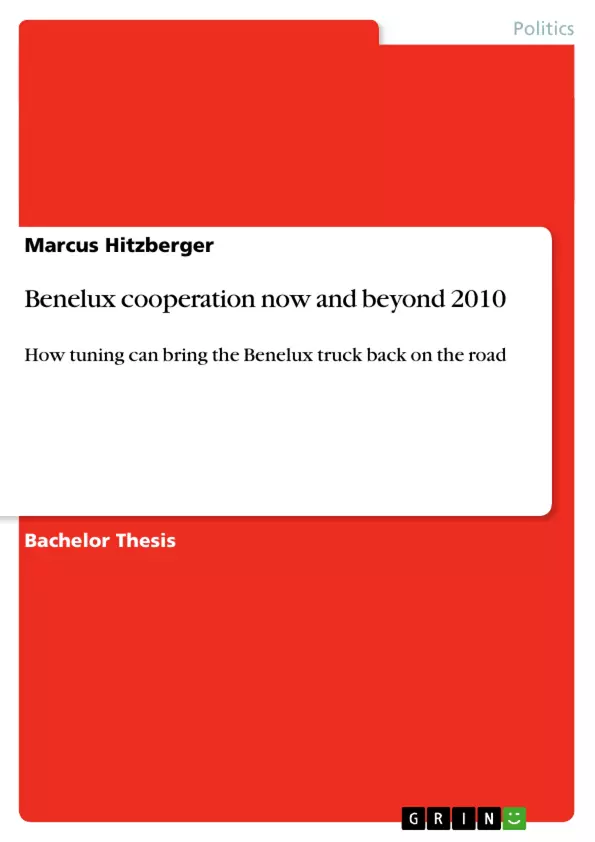Mit dem Auslaufen des BWU-Vertrages im Jahr 2010 befinden sich die Benelux nun am Scheideweg und müssen sich mit der Frage auseinandersetzen, wie sie die zukünftigen legalen Rahmenbedingungen für ihre Zusammenarbeit gestalten wollen. Mehrere Punkte sind hier wesentlich: die veränderte Staatsform Belgiens, die Geschwindigkeit der europäischen Integration, die zukünftige Rolle der Benelux, deren Kernbereiche ihrer Zusammenarbeit, verstärkte politische Zusammenarbeit, etc. Der niederländische Außenminister Pieter Kooijmans bemerkte im Jahr 1994, dass „der Zug der Europäischen Union den LKW der Benelux eingeholt habe“, und meinte dass mittlerweile viele ursprüngliche Benelux Domänen auf Europaniveau exportiert wurden. Die Benelux müssen neuen Antrieb finden um die Funktion, die sie in den frühen Jahren europäischer Integration ausübten, erneut zu übernehmen. Deshalb ist es notwendig, den Benelux LKW in fünf Schritten zu frisieren um seine Vorreiterrolle zu sichern. Dies beinhaltet eine neue Karosserie (neue legale Rahmenbedingung), eine neue Lackierung (Sichtbarkeit), GPS (politische Führung), zusätzliche Achsen (Benelux Plus) und das wichtige Motor-Tuning (Kernbereiche der Kooperation).
The expiration of the BEU-Treaty in 2010 puts the Benelux at crossroads and the three countries have to come to grips with the question of a new legal framework for their cooperation. Here, numerous aspects have to be kept in mind: the modified setup of the Belgian state, the speed of European integration, the future role of the Benelux including its core domains of cooperation, enhanced BPC, etc. In 1994, the Dutch foreign minister, Pieter Kooijmans, once said that ”the train of the European Union has taken over the truck of the Benelux” meaning that many initial Benelux domains have been exported to the European level. The Benelux have to create a new drive to take over the role they had in the early years of European integration. Therefore, five steps are necessary to tune the Benelux truck in order to ensure its outrider role. They include body tuning (new legal framework), new lacquering (visibility), GPS (political steering), additional axles (Benelux Plus) and most importantly engine tuning (core areas of cooperation).
Inhaltsverzeichnis (Table of Contents)
- Abstract
- Introduction
- SWOT Analysis
- Tuning the Benelux Truck
- Conclusion
Zielsetzung und Themenschwerpunkte (Objectives and Key Themes)
This thesis examines the current state of Benelux cooperation and explores the need for a new legal framework to ensure its future success beyond 2010. The study analyzes the historical development of Benelux collaboration, assesses the strengths and weaknesses of the current organization, and identifies opportunities and threats to its future.
- The historical evolution of Benelux cooperation from its origins to the establishment of the Benelux Economic Union (BEU)
- A SWOT analysis of the Benelux organization, highlighting its strengths, weaknesses, opportunities, and threats.
- The challenges facing the Benelux in the context of European integration and the expiration of the BEU-Treaty in 2010.
- The need for a new legal framework and strategies to revitalize Benelux cooperation and ensure its continued relevance.
- Recommendations for "tuning" the Benelux organization to ensure its future success as a laboratory for European policies and a vital player on the international stage.
Zusammenfassung der Kapitel (Chapter Summaries)
- Abstract: This section provides a brief overview of the thesis, outlining its main objectives and key findings. It discusses the historical context of Benelux cooperation, its achievements, and the challenges it faces in the 21st century.
- Introduction: This chapter delves into the origins of Benelux cooperation, tracing its historical evolution from the 16th century to the present day. It examines the key factors that have shaped Benelux relations, including political, economic, and cultural influences.
- SWOT Analysis: This chapter analyzes the strengths, weaknesses, opportunities, and threats facing the Benelux organization. It assesses the organization's strengths, such as its historical role as a laboratory for European integration, its added value, and its well-established Secretariat-General. It also discusses the challenges of the organization, including the caducity of exclusive Benelux domains, the lack of Benelux visibility, and the lack of institutionalized political cooperation.
- Tuning the Benelux Truck: This chapter focuses on the need for a new legal framework for Benelux cooperation in light of the expiration of the BEU-Treaty in 2010. It examines the challenges of the modified setup of the Belgian state, the rapid pace of European integration, and the future role of the Benelux in the context of European policymaking. The chapter also explores the need for a new drive to revitalize Benelux cooperation and outlines five key steps for tuning the Benelux "truck" to ensure its continued success.
Schlüsselwörter (Keywords)
The key terms and concepts explored in this thesis include Benelux cooperation, European integration, legal framework, SWOT analysis, historical development, economic union, political cooperation, BEU-Treaty, laboratory function, visibility, and international relations.
- Arbeit zitieren
- Marcus Hitzberger (Autor:in), 2007, Benelux cooperation now and beyond 2010, München, GRIN Verlag, https://www.grin.com/document/74824



